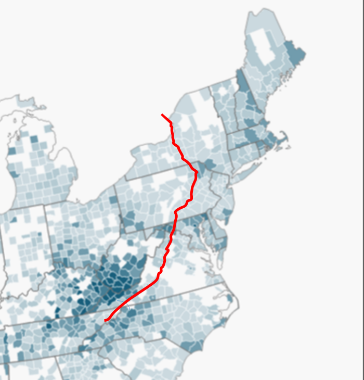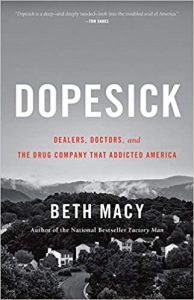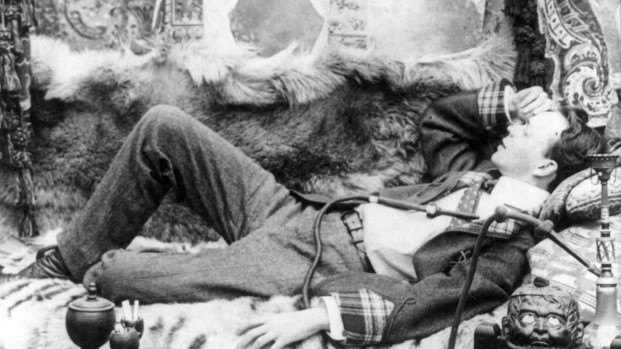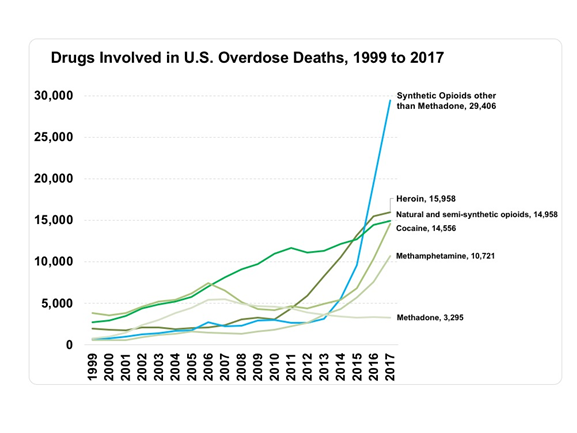The Opioid Crisis:
Victimizing White America with No End in Sight
Morris van de Camp
Beth Macy
Dopesick: Dealers, Doctors, and the Drug Company that Addicted America
New York: Little, Brown and Company, 2018
There is a heavy price to be paid for white dispossession. During the 1970s, white “ethnics” in the North indemnified dispossession when their schools and neighborhoods were destroyed by integration. From 1999 until the present, that cost has been borne primarily by rural whites from Appalachia. This most recent payment has taken the form of a plague of addiction to a family of drugs called opioids.
Opioids of some type have been around since Neolithic people discovered that dried poppy seeds are painkillers. Over time, the psychoactive properties within those seeds have been studied, concentrated, and improved upon. By the nineteenth century, there was laudanum and morphine for medical use, and smokable opium for recreational use. By the late twentieth century, pharmacists developed OxyContin, and there is a synthetic, very powerful form of the drug called fentanyl.
Opioids have two factors that make them dangerous. First, they work extremely well at killing pain, so there is always a reason for opioids to be around in some form. Second, in any form, they are highly addictive, and the withdrawal symptoms for an addict are extremely horrific. An addict “fiends” for more opioids to avoid being “dopesick.”
Plagues of opioid addiction are not new. It is well known that many Chinese, and much of the rest of the Orient, were hooked throughout the nineteenth century. Hong Kong, which was then a British colony, existed primarily to facilitate the Chinese opium trade. Indeed, a great many Americans of Yankee extraction, including the Delano family of Franklin Delano Roosevelt, made piles of money in shipping opium from British India to China.

Opioid addiction then and now.[1]
Opioids are a symptom of white displacement due to the intersection of various factors which are described in Beth Macy’s 2018 bestselling book, Dopesick: Dealers, Doctors, and the Drug Company that Addicted America. Beth Macy doesn’t mention white displacement, the JQ, or anything like that in her book, but it’s easy to see for a redpilled white advocate. Macy focuses her story on western Virginia.
The first thing that led to the opioid crisis was when the FDA approved the drug OxyContin. (This will be further explained below.) After this came a set of laws and trade deals which served to cripple the western Virginian economy as well as the rest of Appalachia, rendering the population underemployed and with many idle hours they could pass by using drugs. Macy doesn’t mention this, but as I spent some time in Midwestern coal country, I must: The Clean Air Act of 1963 basically made bituminous coal, which is abundant in Appalachia, unusable, favoring lignite coal, which is mined elsewhere. One by one, the coal mines started to close. The Obama administration accelerated this trend with its own environmental laws. Alternative forms of energy, such as wind and natural gas, also helped to close the mines.
Coal miners are typically smart and hardworking, however, and under normal circumstances, many could have found new types of blue-collar jobs. But this couldn’t save them from the next disaster in the series. The next factor – and perhaps the biggest – came in the form of free trade treaties. NAFTA and trade with China destroyed the region’s industrial base, along western Virginia’s Interstate 81. Furniture and clothing factories closed, laid off their workers, and shipped the factories south of the border or to Asia. In some places, the locals managed to start new industries; Charlottesville and Roanoke are cities with thriving economies today. But on the whole, the chill of unemployment set in. Getting on disability became the new job.
What made the OxyContin crisis so different is that this drug originated in America’s mountain backcountry. Typically, writes Macy, “[w]hen a new drug sweeps the country, it historically starts in the big cities and gradually spreads to the hinterlands, as in the cases of cocaine and crack. But the opioid epidemic began in exactly the opposite manner, grabbing a toehold in isolated Appalachia, Midwestern rust belt counties, and rural Maine.”[2] Those on disability who were diagnosed with chronic pain were prescribed OxyContin, and quickly became hooked.

Heroin Highway: In this image, Interstate 81 is highlighted on a map of 2015 opioid deaths by county.
Western Virginia addicts got hooked in part because of their culture. Many people in Appalachia trace their roots to the deeply Protestant borderer culture of Ulster, Ireland, and the borderlands of England and Scotland. This culture developed in the most violent, least governable parts of Great Britain and Ireland. It encourages personal honor, self-reliance, individual freedom, and tolerates illicit activities such as moonshining. Tragically, it is an easy step from the latter to dealing in opioids. The people of this region work hard, but not in the steady way Americans in the more industrial Midlands work. It’s a work hard, play hard ethos, and there is a reason why songs like Johnny Cash’s “Sunday Morning Coming Down” originated from this region.

Top: Protestant settlements in Ulster in 1766. Middle: the borderlands of England and Scotland. Bottom: Appalachia.
Bearing in mind the cultural background of western Virginians, it becomes easy to understand how the drug spread. Unemployed people on disability and Medicaid could get OxyContin very cheaply, and they sold their surplus pills. They also taught their neighbors how to work the system to get opioids. An entire industry was born out of a killer business model: if you don’t continue to use the product, you get terribly sick. In the poorest of rural districts, addicts sold their mules, livestock, and land to get the drug. Other addicts stole tools and small-engine machines such as lawnmowers. When the drug spread to the wealthy town of Roanoke, high schoolers stole their parent’s credit cards and pawned jewelry to maintain their habits.
A typical journey into addiction works in the following way: A person is injured, is prescribed an opioid, and gets hooked. Others – often teenagers with the poor judgement of youth – get hooked through recreational use. Those who are prescribed it for medicinal reasons simply feel less pain when they begin to use, but for those who use it recreationally, the high is great at first. Recreational addicts continually seek to recapture that first high by increasing the dosage, but as their body’s tolerance to the drug increases, they never can. Often, opioid users are young men who were prescribed Ritalin as a boy. And in many cases, an addict’s introduction to drugs are via “legal” prescription drugs, but he eventually moves to heroin, which is cheaper and easier to get illicitly.
Once one is an addict, a series of bad choices follow that often land one in jail. There are several schools of thought as to how to get clean. There is abstinence (going cold turkey), a medicinally assisted process (i.e., using methadone, suboxone, or other such prescription drugs). It typically takes an opioid addict eight years to achieve one year of sobriety. That is, of course, if he doesn’t die of an overdose first. If a person dies of an overdose, often his dealer will get more customers, given that other addicts will understand that his dealer is peddling more powerful stuff.
Opioids and White Displacement: In-depth Observations
Observation 1: Failure to Manage Jews as a Hostile, Subversive Force
When reading this book, or other works on the same subject, one really comes to see the tragedy of white displacement. The truth of the opioid crisis is that a group of Jews developed a business model along the lines of the nineteenth-century opium trade in China and applied it to American whites. As Counter-Currents uber-eccentric writer Buttercup Dew has said when comparing the androids of the Alien series of films to Jews, “[The Jews] are literal cold-blooded killers who are effortlessly able to understand and emulate [Gentile] emotion, but their empathy comes without sympathy. They are the other, the sociopath that whilst able to manipulate and interact with the [Gentile] flock, is detached from their suffering and identifies as a different creature entirely.”
This massive network of readily available opioids came about in the early 1990s, and Jewish fingerprints are all over this development. The Sackler family, Brooklyn-based Jews, developed OxyContin, which was just opium in a new form. Previously, the Sacklers had enjoyed great success in selling Valium. The FDA approved OxyContin in 1995. The Sackler’s company, Purdue Pharma, built an army of salesmen to market OxyContin to doctors in the late 1990s and early 2000s.
Purdue Pharma launched a campaign to convince doctors and consumers that OxyContin was not addictive by deliberately misrepresenting the data. When they couldn’t distort the data, Purdue Pharma’s managers simply lied. Indeed, whenever one gets to the bottom of a social disaster, it is remarkable just how often a Jew is the primary culprit. Jewish doctors and pharmacy executives made billions and still escaped with their freedom and fortunes intact. Three Purdue Pharma executives were convicted in 2007, but these convictions were nothing compared to the crime.
Observation 2: “Civil Rights” for People of Color is a Disaster for Whites
The opioid crisis also has a non-Jewish, non-white predatory cause. Many illegal Mexican immigrants are dealing heroin to Appalachian whites. There is also a large heroin supply in mostly black Baltimore that is managed (at least at the street level) by rather shrewd Sub-Saharan dealers. Black dealers package their heroin wearing a mask and gloves, with all of it destined for the mountains.
There is also a racial angle as to how opioids like heroin and fentanyl slip into the United States. The large Chinese community in Vancouver, British Columbia is heavily involved in the fentanyl trade. It is as though Vancouver has become the modern-day Hong Kong. Simultaneously, heroin is dealt by illegal Mexican immigrants across the Rust Belt after being smuggled across the border.
A Disconnected Political Class
If one compares what was going on in mainstream politics as the opioid crisis gained momentum, one sees that the political class was distracted at best, or completely indifferent at worst. The outsourcing of manufacturing jobs began under Clinton in the late 1990s and accelerated under Bush. Few, if any, elected public officials of either party concerned themselves with this development. The Bush administration’s economic policies, such as they were, focused on extending mortgages for non-white homeowners. This ended up triggering a global recession that only made the situation worse.
The 2006 United States Senate race in Virginia didn’t mention the opioid crisis. As usual, there was a media-manufactured “racism” incident involving the incumbent Republican Senator, George Allen. As the “racism” incident was ongoing, Senator Allen insisted he was in touch with the “real” Virginia, but missed mentioning the crisis despite the fact that he was campaigning in Breaks, Virginia, which is deep within the geographical heart of the epidemic. In the debates with his opponent, Jim Webb, the opioid crisis was never mentioned, and the two men instead sparred over American policy in Iraq. During one debate, the men symbolically donned different types of footwear: Allen, who sympathized with the neocons, wore cowboy boots, while Webb wore his son’s combat boots. In other words, one Jewish-caused debacle served as a smokescreen for another such debacle: opioids.
Nobody discussed opioids during the 2008 or 2012 elections, either, but then-candidate Obama did express his disdain for Appalachians and those in the Rust Belt who were suffering from the opioid threat when he said, “They get bitter, they cling to guns or religion or antipathy toward people who aren’t like them, or anti-immigrant sentiment, or anti-trade sentiment, as a way to explain their frustrations.” One might say, anti-trade and anti-immigrant sentiment on the part of the “clingers” was actually a rational assessment of the situation.
Hillary Clinton called these voters “deplorables,” but conventional Republicans were not much different. Kevin Williamson of the National Review insisted that:
The truth about these dysfunctional, downscale communities is that they deserve to die. Economically, they are negative assets. Morally, they are indefensible. Forget all your cheap theatrical Bruce Springsteen crap. Forget your sanctimony about struggling Rust Belt factory towns and your conspiracy theories about the wily Orientals stealing our jobs. Forget your goddamned gypsum, and, if he has a problem with that, forget Ed Burke, too. The white American underclass is in thrall to a vicious, selfish culture whose main products are misery and used heroin needles. Donald Trump’s speeches make them feel good. So does OxyContin.
Observation 4: White Advocates Also Missed the Boat
In Dopesick, the heroes, if there are any, are the overdose victims’ families, as well as the doctors and social workers in the area who had to deal with the crisis face-to-face and sought in vain to raise awareness of the problem.
One thing worth mentioning is that, in this author’s career in white advocacy, I’ve noticed that Jews can easily get audiences with senior government officials, and the latter usually easily and quickly grant their wishes. On the other hand, those doctors and others who have given their lives to community service often have a difficult time in getting their ideas across even to a lower-level official.
As far as this author can tell, no white advocates were involved in the earlier phases of this crisis. White advocates did indeed broadcast the situation as it became more generally known after a 2015 report which brought it to national attention, but we weren’t in the lead on this issue. Should we take the lead on the next issue, white advocacy will make great forward strides.
Conclusion
Opioid addiction is creating a series of collateral disasters that need to be known. If two parents overdose, three days later, their unattended baby will succumb to dehydration. Furthermore, an entire culture of trust is being destroyed. Unlocked toolsheds are vanishing across the Highland South. Additionally, industriousness itself is cracking under the pressure, given that for many, it is better to be on disability than employed. One doesn’t get laid off from the breadlines, but working overtime to get promoted to factory foreman is all for naught if the factory gets moved to Ching-Chong City to bump the company’s stock price up by ten cents a share. And what investor in his right mind would ever put capital into an area with such a spotty workforce?
Several recommendations:
- Government regulatory bodies need to operate with the assumption that Jews are not acting in good faith towards society in general.
- The opioid crisis is here for the long term. The trick is to manage the existing addicts and prevent new ones from being created. We have a lost generation.
- It is no longer an issue only for law enforcement. It should be treated as a plague. Contradictory approaches – like cold turkey versus methadone – should be funded by both the government and the private sector. People need options. This is a crisis, and different approaches are needed. Needle exchanges and methadone clinics need to be sponsored without the moralizing hand-wringing. Such institutions won’t be like the 1970s drug clinics of Harlem. Rural clinics don’t attract drive-by shootings.
- We must also face the darkness, and learn to make use of it. Opioids are here to stay, and are profitable. To paraphrase Madeline Albright, what’s the point of having a superb, devious (and mostly worthless money-pit) like the CIA if you can’t use it to get opioids to, say, the Gulf States, or China, or Israel? Why should we suffer sober rivals?
- The opioid crisis is partially the result of free trade. It isn’t “trade” in general, it is the result of very specific trade deals. Reevaluate all the economic relationships with Asia.
Below is a poem written by a Lee County, Virginia doctor regarding the crisis:
OxyContin
Dr. Art Van Zee
It might have been easier
If OxyContin swallowed the mountains,
and took
The promises of tens of thousands
of young lives
Slowly, like ever-encroaching kudzu.
Instead, It engulfed us,
Gently as napalm
Would a school-yard.
Mama said
As hard as it was to bury Papa
after the top fell in the mine up Caney Creek,
it was harder yet
to find Sis that morning
cold and blue, with a needle stuck up her arm.
Top of her class,
with nothing but promise ahead
until hi-jacked by
the torment of needle and spoon.[3]
Notes
[1] Watch this video to see how Narcan works.
[2] Macy, Dopesick, p. 7
[3] Macy, Dopesick, p. 89, originally published in the Annals of Internal Medicine.
The%20Opioid%20Crisis%3A%20Victimizing%20White%20America%20with%20No%20End%20in%20Sight
Enjoyed this article?
Be the first to leave a tip in the jar!
Related
-
The Significant and Decisive Influence that Leads to Wars
-
Whither Thou Goest, Diaspora?
-
The Terrible Loss of an American Patriot
-
Thoughts on Decadence and the American Ethos
-
Dealing with the Opioid Crisis at the Strategic Level
-
Kabbalistic Jewmanoid Underground Tunnelers
-
Kabbalistic Jewmanoid Underground Tunnelers
-
Losing a Lose-Lose Scenario





14 comments
Excellent article and very well written. I take no issue with what you have written per se regarding the causes and effects of the opioid and other drug epidemics affecting White folk.
However, I THINK (emp. Think because I don’t presume to know) you and others who have written on the subject (e.g. “Methland” by Nick Reding) are over developing the concept of White victimization. They come across as hopeless children who cannot control their lives let alone their destinies.
God created the Devil (metaphorically speaking … I’m not religious) but he gave us free will and the ability to fight the devil. In your presentation the Jew acts the role of the Mephistopheles and Whites Faustus. Like Faustus they sell their souls for physical enjoyment. Like Faustus, Whites have a choice.
While we must help them physically in ways you suggest, unless they get help spiritually (pride in their Whiteness; their history and culture) no amount of physical antidotes will solve the problem.
There is a great scene in Mel Gibson’s film “The Passion of the Christ” (the only scene worth see the film) of Jesus being tempted by the Devil in Gethsemane. He struggles with his desire to give in to the Devil’s admonitions. Finally, he gets the courage and determination and steps on it and walks out of the garden to face his destiny with dignity. White folk are in the garden and they are succumbing to the temptation of physical pleasures (not just drugs; but consumer credit is also a debilitating addiction to material titillations like iPhones and cars). Unless and until they are moved by the spirit and step on the tempters, they will continue to sink to the spiritual, economic and cultural abyss.
I didn’t want to focus on personal accountability as Appalachia has enough fire and brimstone ministers and that clearly hasn’t worked.
I do discuss the “Sunday Morning Coming Down,” moonshine culture of the region.
Thank you for your reply. However, I hope you did not take my comment as any sort of criticism of you work. Obviously, this is a very very complicated social/cultural/historical problem for which there are may facets. You admirably dealt with a part of that complex, and are to be commended for bringing it to the attention of others. I was just expanding on your work.
Also, I appreciated the link to the Johnny Cash song. In fact I think that was the impetus of my comment. Frankly, the song bothered me so much that I could not finish listening. I got to the part where the narrator saw children in the park and I said ‘that’s enough for me’.
Thank again … keep on write’n!
Have you ever read The Continuum Concept, Chapter 5, “Deprivation of Essential Experiences”and the author’s idea of just why people love heroin (and other kinds of dope and certain activities) so much?
Not saying anything either way myself, don’t know the truth about such things, not saying it’s the whole story – only that it is worth reading because the practices she promotes are definitely the way to go even though there are no guarantees your children will “turn out” perfect. Further, I don’t agree with every single thing this author has ever said on every topic. She doesn’t know everything; does anyone?
I suspect some folks would be highly bothered by the claims made; they want to think that drug addiction is directly caused by either juze or a bad economy.
The Right Honorable Rodrigo Duterte; he might have some excellent suggestions towards curtailing this problem drastically.
Not that I cannot see Chinese peddling fentanyl to whites to make money, but what is the evidence for that claim?
Just google some variation of fentanyl + Vancouver + Chinese.
Why does it feel like every racial group is doing their damndest to kill us?
An interesting vid on the Tribal interest in the Opium War is this – though it is somewhat spoiled by the larpy stuff at the end ; https://www.youtube.com/watch?v=BGDiYofpwvI
Very good article. You mentioned Vancouver, BC . The RCMP and the newly formed CSIS (Canadian Security Intelligence Services) in a joint operation code named Operation Sidewinder investigated subversive Chinese influence in Canada. However, “Operation Sidewinder was abruptly disbanded before the document was leaked. Apparently all copies were ordered destroyed, and the “rest were lost”. No one’s quite sure who ordered the documents destroyed. It’s believed the project died under pressure from within and outside the agencies.”
https://metroactive.org/wordpress/2017/04/29/rcmp-csis-sidewinder-report-warns-of-chinese-government-control-over-canada/
https://betterdwelling.com/csis-warns-of-chinese-influence-on-canadian-real-estate-20-years-ago/
Very interesting links.
The Australian writer Clive Hamilton published a book called ‘Silent Invasion’ earlier this year about the growing influence of Chinese nationals and the Chinese government on Australian affairs.
Hamilton would generally be thought of in the US as a ‘leftist’ because of his views on climate and the environment. He has published a number of serious works of non-fiction that were generally well received by critics.
Despite this, Silent Invasion created a storm of controversy. Three publishers walked away from it. The politician who had agreed to launch the book pulled out. Australia’s laughable Race Discrimination Commissioner, Tim Soup(hommasane) predictabily called Hamilton a racist. All this despite the book repeatedly making statements about how Chinese Australians should be respected etc etc.
The point is not that the book’s anything great – it isn’t. It states the bleeding obvious but presents it in a reasonable, almost scholarly way. The hysterical reaction of the establishment to this most gentle exposure says more about the establishment’s ties to the current economic benefactor (China having superseded the UK and the US in this role) than anything Hamilton says himself.
The unthinkable concept of Australia as a genuinely independent nation-state seems to cross Hamilton’s mind at times – and for this he’s now in the dog house.
https://clivehamilton.com
.
Quite a few years ago I had a dream (!) about America.
This is unusual since I don’t spend too many waking hours thinking about America one way or the other.
In this dream, the US was ruptured by the secession of a region – that region was Appalachia. In the dream, Appalachia left the US so it could adopt its own system of money creation – no fractional reserve banking, no money created as interest bearing debt, no usury. The nation of Appalachia was (somehow) defined through a family tree on the internet. If you weren’t related, you weren’t in.
As is the nature of dreams, I was wearing a really cool green shirt. A woman who looked like Daisy Duke was there. It felt great. I can’t remember much else.
No opioids were involved, but somehow it felt like they should’ve been.
.
Let’s put the methadone clinics in wealthy upper class areas for a change. My neighborhood is overrun with panhandlers and dirty needles are found everywhere.
Seems that a new opioid, Dsuvia, is being developed. https://www.youtube.com/watch?list=PLD841087C099E5B90&time_continue=94&v=n9wIU-xErq4
Comments are closed.
If you have Paywall access,
simply login first to see your comment auto-approved.
Note on comments privacy & moderation
Your email is never published nor shared.
Comments are moderated. If you don't see your comment, please be patient. If approved, it will appear here soon. Do not post your comment a second time.
Paywall Access
Lost your password?Edit your comment